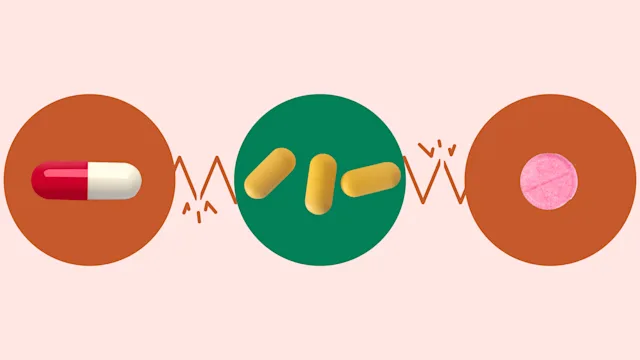Key takeaways:
Vimpat (lacosamide) is a prescription medication that’s FDA approved to treat seizures in adults and children. It can be taken on its own or with other anti-seizure medications.
Without insurance, 60 tablets of brand-name Vimpat 100 mg cost about $1351.78. Insurance coverage for Vimpat varies widely by plan type, with Medicaid covering the highest percentage of enrollees.
If you’re eligible to participate in the manufacturer’s direct-to-patient program, you could pay as little as $84.99 for 60 tablets of brand-name Vimpat or $79.99 per 60 tablets when ordering 180 or more tablets at one time.
Save on related medications
Vimpat (lacosamide) is a prescription medication that’s FDA approved to treat certain types of seizures in adults. It also treats partial-onset seizures for children ages 1 month and over and tonic-clonic seizures for children 4 years and older. Vimpat comes in two oral forms: tablets and a liquid solution. It also comes as an IV infusion, although the IV form is typically used only temporarily when oral administration is not possible. You can take Vimpat on its own or with other anti-seizure medications, depending on your treatment plan.
Insurance coverage for Vimpat can vary widely. Many plans, including Medicaid, often require prior authorization before covering the medication. Whether you have insurance or not, there are still ways to save on Vimpat, including using a GoodRx coupon.
How much does Vimpat cost?
Without insurance, 60 tablets of brand-name Vimpat 100 mg cost an average of $1351.78. By comparison, the average retail price for one 600 mL bottle of oral liquid is $1625.36 without insurance, coupons, or discounts.
Your actual cost depends on several factors, including:
Location: Medication prices can differ widely based on where you live. For instance, GoodRx data shows that someone in Atlanta will likely pay less for their prescriptions than someone in Milwaukee.
Generic vs. brand-name: Vimpat is available as a lower-cost generic, lacosamide, which can help you save money. You might pay around $1004.70 for 60 tablets of generic Vimpat 100 mg without insurance, coupons, or discounts.
Pharmacy choice: Prices for Vimpat can vary from one pharmacy to another, even within the same area.
Insurance coverage: Even with an insurance plan that covers Vimpat, you might still have out-of-pocket expenses such as copays, deductibles, and coinsurance.
Form: The form of Vimpat you need can also affect the price of your prescription. For example, the oral solution may cost more than the tablets.
Dosage: The cost of Vimpat can vary depending on the prescribed dosage. Common starting doses include 50 mg or 100 mg twice daily, but a healthcare professional may adjust the dose based on your needs and how well you tolerate the medication. Higher doses may cost more.
Discounts: Your cost for Vimpat may be reduced if you qualify for the manufacturer’s direct-to-patient program, download a GoodRx coupon, or find other savings programs.
Does insurance cover Vimpat?
Some health insurance plans, including Medicare, Medicaid, and commercial options, cover Vimpat.
More than 3 in 5 people enrolled in Affordable Care Act (ACA) marketplace plans have coverage for Vimpat. Almost half of enrollees will need prior authorization. But nearly one-fourth will require step therapy (trying lower-cost alternatives first) before receiving coverage for Vimpat.
Commercial plans cover Vimpat for more than half of enrollees, and only about 1 in 5 need prior authorization or step therapy for coverage. Nearly all Medicaid enrollees receive coverage for Vimpat, but it is common for Medicaid enrollees to require prior authorization or step therapy.
To determine how your insurance covers Vimpat, refer to the formulary for your health plan or contact your insurer directly.
How different insurance plans cover Vimpat
The table below shows how likely it is that Vimpat will be covered by different types of insurance plans. It also shows whether prior authorization or step therapy might be required.
Insurance type | Enrollees covered for Vimpat 50 mg, 100 mg, and 200 mg tablet | Enrollees required to get prior authorization | Enrollees required to do step therapy |
|---|---|---|---|
61.4% | 45.7% | 22.9% | |
Commercial plans (excluding ACA plans) | 57.3% | 22.5% | 18.1% |
Medicare (original Medicare and Medicare Advantage plans) | 6.6% | 1% | 1% |
Medicaid, including state-run and managed care plans | 99.9% | 62.6% | 28.9% |
Source: Managed Markets Insight & Technology, LLC™, as of June 13, 2025. (See methodology below.)
If your insurance does not cover Vimpat, consider these options:
Talk to your prescriber about switching to the generic or a different medication that may be covered by your insurance, or come with lower out-of-pocket costs than Vimpat.
Call your insurance company to request a formulary exception for Vimpat. This is a special request asking them to cover Vimpat in your case.
If the exception is denied, you can file an appeal.
During the next open enrollment, choose an insurance plan that offers better coverage for your medication needs.
Make the most of your FSA funds: See how you can use your flexible spending account (FSA) to cover Vimpat and other eligible expenses.
Looking for ways to save? From GoodRx coupons to manufacturer copay cards, here are some ways to get help paying for your medications.
Common side effects: Learn about the most common Vimpat side effects and when you should contact your prescriber.
Ways to save on Vimpat
Whether you have insurance or not, here are seven ways to save on Vimpat:
1. Download a GoodRx coupon
A free GoodRx coupon could help lower the cost of your Vimpat prescription. It’s important to note that not all pharmacies will accept GoodRx coupons for controlled substance prescriptions, such as Vimpat. It’s a good idea to call ahead and confirm with your pharmacy before using a coupon.
The table below shows what you may pay for different doses, forms, and quantities of Vimpat with a GoodRx coupon.
Formulation | Dose | Price with a GoodRx coupon |
|---|---|---|
60 tablets of Vimpat (brand-name) | 50 mg | |
60 tablets of Vimpat (brand-name) | 100 mg | |
60 tablets of Vimpat (brand-name) | 150 mg | |
60 tablets of Vimpat (brand-name) | 200 mg | |
60 tablets of lacosamide (generic) | 50 mg | |
60 tablets of lacosamide (generic) | 100 mg | |
60 tablets of lacosamide (generic) | 150 mg | |
60 tablets of lacosamide (generic) | 200 mg | |
One 600 mL bottle of Vimpat oral liquid | 10 mg/mL | |
One 1,200 mL bottle of Vimpat oral liquid | 10 mg/mL |
To get your GoodRx coupon for Vimpat:
Go to www.goodrx.com, or download the GoodRx app on your phone.
Search for “Vimpat.”
Enter your prescribed dose, form, and quantity, then set your location.
Click “Find the lowest prices” or press “Enter.”
Have the coupon sent by text or email, or print it out.
To apply the discount, show the coupon at the pharmacy when you fill your prescription. Ideally, this is done at drop-off before the prescription is filled.
2. Check if you qualify for Vimpat’s Direct-to-Patient Program
If you have a prescription for Vimpat tablets, you may be eligible for the Vimpat direct-to-patient program. This program offers brand-name Vimpat for as little as $84.99 for 60 tablets if you meet eligibility criteria. If you order 180 or more tablets at once, you could pay as little as $79.99 per 60 tablets.
Some of the conditions for participating include:
You must have a valid prescription for Vimpat tablets that aligns with FDA-approved uses.
You must be a U.S. resident, including U.S. territories.
You cannot submit claims for reimbursement to any insurance plan, including Medicare or Medicaid.
The program operates outside third-party insurance and cannot be combined with other savings offers.
3. Ask about the generic version of Vimpat
The generic version typically costs much less than brand-name Vimpat, whether you’re paying out of pocket or using insurance. For example, 60 tablets of Vimpat 100 mg cost an average of $1351.78, while the generic version costs about $1004.70. Since generic medications work the same way as brand-name prescriptions, switching to generic Vimpat could be a simple way to lower your medication costs.
4. Request a larger supply
Getting a 90-day supply of Vimpat instead of refilling your prescription each month could help you save money. Some insurance plans — including those that use mail-order or specialty pharmacies — offer lower copays or discounts for 3-month prescriptions. Check with your insurance provider to see if this option is available. If it is, ask a healthcare professional if they can prescribe you a 90-day supply to help reduce your out-of-pocket costs.
5. Consider a lower-cost alternative
In addition to Vimpat, there are other antiepileptic (anti-seizure) medications that can help treat partial-onset seizures, and they may cost less. Talk to your prescriber about lower-cost alternatives that may be a good option for you.
6. Use your insurance’s preferred specialty pharmacy
If your insurance requires you to get Vimpat through a specialty pharmacy, make sure to use one in your plan’s network. This can help reduce your out-of-pocket expenses.
Using a preferred specialty pharmacy may also come with added benefits, such as lower copays, help with refills, and access to financial assistance programs. To find out which pharmacies are covered under your plan, contact your insurance provider or check your plan documents.
7. Use your tax-advantaged health account to pay for Vimpat
If you have a health savings account (HSA) or a flexible spending account (FSA), you can use those pretax funds to pay for prescription medications like Vimpat. HSA funds never expire, so you can always use the money in your account to cover qualified medical expenses. But FSA funds typically expire at the end of the plan year unless your employer offers a carryover option or grace period.
The bottom line
Without insurance, 60 tablets of brand-name Vimpat (lacosamide) 100 mg can cost $1351.78 on average. What you pay will depend on factors like your pharmacy, medication form, and insurance coverage.
If you qualify for Vimpat’s direct-to-patient program, you could pay as little as $84.99 for 60 Vimpat tablets or $79.99 per 60 tablets if you order 180 or more tablets at once. Other ways to save include using a GoodRx coupon, asking about the generic version, or using tax-advantaged health accounts to help cover out-of-pocket costs.

Why trust our experts?


Methodology
We obtained national prescription coverage data for each medication from Managed Markets Insight & Technology (MMIT). The data reflects health insurance coverage as of June 2025.
We calculated the percentage of enrollees in plans that cover each medication by dividing the number of enrollees covered for the medication within a specific insurance channel (e.g., ACA, Medicare, Medicaid) by the total number of enrollees in all plans within that channel.
We determined the percentage of enrollees in plans with a prior authorization requirement by calculating the proportion of enrollees in plans that required prior authorization for the medication within each channel.
Finally, we measured the percentage of enrollees in plans with a step therapy requirement by calculating the proportion of enrollees in plans that imposed step therapy requirements for the medication in each channel.
These estimates, derived from national MMIT coverage data, provide insight into health insurance coverage for each medication. They take into account restrictions such as prior authorization, step therapy, and quantity limits. The percentages are expressed relative to the total number of enrollees covered by various insurance channels, including ACA plans, commercial (excluding ACA) plans, Medicare, and Medicaid (both state-run and managed care plans).
References
HealthCare.gov. (n.d.). Appealing a health plan decision. Centers for Medicare & Medicaid Services.
Medicaid.gov. (n.d.). Managed care. Centers for Medicare & Medicaid Services.
UCB. (2025). Vimpat- lacosamide tablet, film coated, Vimpat- lacosamide injection, Vimpat- lacosamide solution [package insert]. DailyMed.











